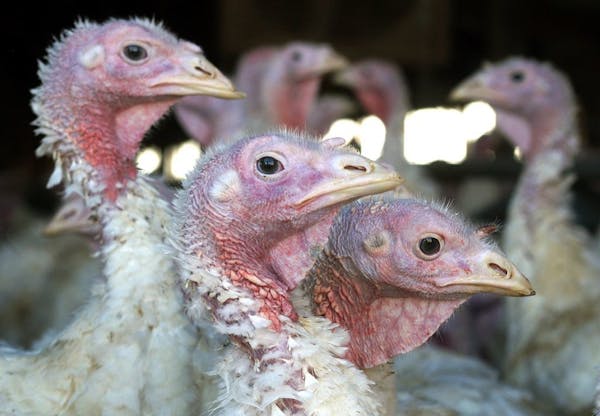Bird flu has hit an eighth Minnesota turkey farm, the second such occurrence in Kandiyohi County, animal health regulators said Tuesday.
Highly pathogenic H5N2 bird flu has been found in a flock of 30,000 turkeys in Kandiyohi, the state's largest turkey-producing county. Turkeys in one of the farm's three barns came down with the flu. As is common in such outbreaks, turkeys in the other two barns were killed as a precaution.
The farm has been quarantined, so birds can't be moved in or out. The dead birds will be composted on site for about four weeks.
The second Kandiyohi County outbreak occurred 3 to 4 miles from another farm struck by bird flu in the past few days.
The flu is believed to be spread by migratory birds who don't get sick themselves. The virus is transmitted through wild bird feces, and is somehow making its way into commercial turkey barns, which are enclosed from the elements.
With this new outbreak, 373,000 Minnesota turkeys will have died from the flu or been euthanized to prevent the disease's spread. Minnesota, the nation's largest turkey producer, churns out about 46 million turkeys a year.
The Minnesota Animal Health Board and the U.S. Department of Agriculture have about 50 people working on stopping the outbreak and figuring out how it has spread. The industry is boosting "biosecurity" measures: limiting farm access for people and machinery, and intensely cleaning both if they go into a barn.
The flu first appeared early last month at a Pope County turkey farm, but has surfaced at seven more operations in the last 10 days. The state's animal health board said state law doesn't allow the release of farm names or exact locations.
The bird flu also has been reported recently in eastern South Dakota, Arkansas and Missouri, and earlier this year in several western states. While chickens can get the H5N2 bird flu, turkeys have been much more susceptible to the virus.
The H5N2 bird flu poses a low health risk to people, health experts say, though workers at afflicted turkey farms are being monitored by state health officials. Birds from affected flocks do not enter the human food system, as they are destroyed, the animal health board says.
Mike Hughlett • 612-673-7003
In heated western Minn. GOP congressional primary, outsiders challenging incumbent

Minnesota Sports Hall of Fame: A class-by-class list of all members

This retired journalist changed professional wrestling from Mankato

